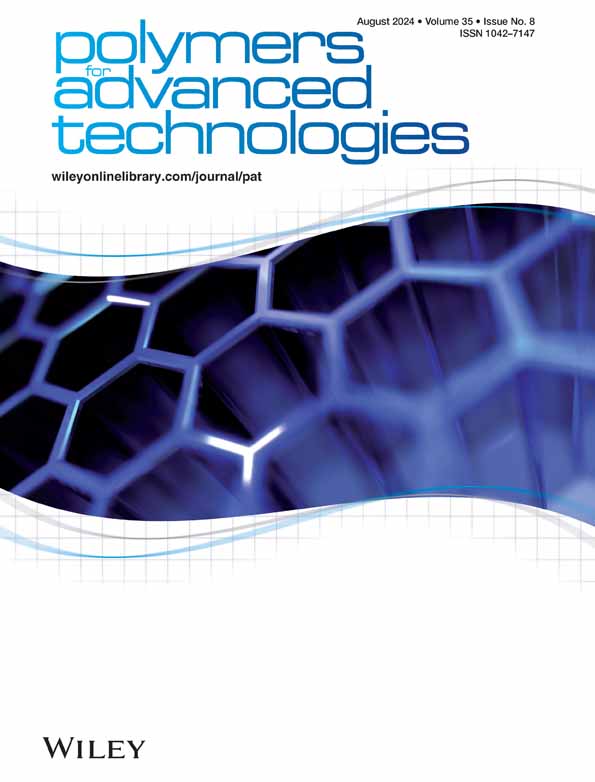利用金属阳离子协同多巴胺改性碳纤维,提高纤维与橡胶之间的界面性能
IF 3.4
4区 工程技术
Q2 POLYMER SCIENCE
引用次数: 0
摘要
CF-PDA-M 混合填料是由三种金属阳离子(M)通过 Fe3+、Ni2+ 和 Al3+ 辅助聚多巴胺(PDA)制备而成。金属阳离子可促进 PDA 在纤维表面的聚合,缩短纤维的改性时间,确保短切碳纤维(CF)在水浴搅拌过程中不团聚,同时保持碳纤维的结构不受破坏,是一种绿色高效的方法。经过 PDA 改性后,纤维表面的粗糙度和表面活性都有所提高。最后,将 CF-PDA-M 作为填料添加到氯丁橡胶胶乳和天然胶乳中,通过湿法混合制备成复合材料,并通过不同的技术对 CF 进行表征。结果表明,CF-PDA-M 表面的羟基和氨基增加了复合材料的交联密度,建立了良好的应力交联网络,缩短了硫化时间,有效防止了 CF 在橡胶中的团聚现象,提高了 CF 在复合材料中的分散性。改性后,CF-PDA-M 的拉伸强度和 300% 恒定拉伸强度比 CF 复合材料分别提高了 10% 和 30% 以上,并且降低了滚动阻力。该研究为 CF 表面功能化提供了一种新的有效策略,提高了橡胶制品的加工效率和机械性能,在橡胶工业中具有广阔的应用前景。本文章由计算机程序翻译,如有差异,请以英文原文为准。
Improving interface performance between the fibers and rubber using metal cations synergistic polydopamine to modify carbon fibers
CF‐PDA‐M hybrid fillers are prepared by three metal cations (M) assisting polydopamine (PDA) through Fe3+ , Ni2+ , and Al3+ . The metal cations promote the polymerization of PDA on the fiber surface, shorten the modification time of the fibers, and ensure that the short‐cut carbon fibers (CF) do not agglomerate during water bath stirring while keeping the structure of the CF undamaged, which is a green and efficient method. After PDA modification, the roughness and surface activity of the fiber surface increase. Finally, CF‐PDA‐M is used as a filler and added to neoprene latex and natural latex, which are prepared into composites by wet blending, and the CF are characterized by different techniques. The results show that the hydroxyl and amino groups on the surface of CF‐PDA‐M increase the cross‐linking density of the composites, establish a good stress cross‐linking network, shorten the vulcanization time, effectively prevent the agglomeration phenomenon of the CF in the rubber, and improve the dispersion of the CF in the composite. After modification, the tensile strength and 300% constant tensile strength of CF‐PDA‐M increase by more than 10% and 30%, respectively, over CF composites, and the rolling resistance is reduced. This study provides a new and effective strategy for CF surface functionalization, which improves the processing efficiency and mechanical properties of rubber products and has a broad application prospect in the rubber industry.
求助全文
通过发布文献求助,成功后即可免费获取论文全文。
去求助
来源期刊

Polymers for Advanced Technologies
工程技术-高分子科学
CiteScore
6.20
自引率
5.90%
发文量
337
审稿时长
2.1 months
期刊介绍:
Polymers for Advanced Technologies is published in response to recent significant changes in the patterns of materials research and development. Worldwide attention has been focused on the critical importance of materials in the creation of new devices and systems. It is now recognized that materials are often the limiting factor in bringing a new technical concept to fruition and that polymers are often the materials of choice in these demanding applications. A significant portion of the polymer research ongoing in the world is directly or indirectly related to the solution of complex, interdisciplinary problems whose successful resolution is necessary for achievement of broad system objectives.
Polymers for Advanced Technologies is focused to the interest of scientists and engineers from academia and industry who are participating in these new areas of polymer research and development. It is the intent of this journal to impact the polymer related advanced technologies to meet the challenge of the twenty-first century.
Polymers for Advanced Technologies aims at encouraging innovation, invention, imagination and creativity by providing a broad interdisciplinary platform for the presentation of new research and development concepts, theories and results which reflect the changing image and pace of modern polymer science and technology.
Polymers for Advanced Technologies aims at becoming the central organ of the new multi-disciplinary polymer oriented materials science of the highest scientific standards. It will publish original research papers on finished studies; communications limited to five typewritten pages plus three illustrations, containing experimental details; review articles of up to 40 pages; letters to the editor and book reviews. Review articles will normally be published by invitation. The Editor-in-Chief welcomes suggestions for reviews.
 求助内容:
求助内容: 应助结果提醒方式:
应助结果提醒方式:


